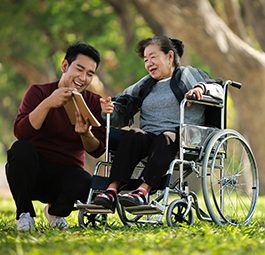Asthma
The September Asthma Peak
September is a challenging month for people with asthma. September brings a number of asthma triggers that cause more asthma attacks, emergency room visits, and hospital stays in this month than any other during the year. This makes it the “Asthma Peak Month.” The third week of September is “Asthma Peak Week,” when asthma episodes typically hit their highest point of the year.
Asthma is a disease that narrows the airways and makes it harder to breathe. The narrowing in the airways is caused by swelling (inflammation), small muscles squeezing around the airways (constriction), and extra mucus. This narrowing can get worse when a person with asthma:
- Breathes in substances that bother the lungs (called “irritants”)
- Has an allergic reaction
- Gets sick
What Causes the September Asthma Peak?
In September, people with asthma come in contact with several asthma triggers at once:
- Weed pollen (especially ragweed)
- Mold
- Respiratory infections
- Poor indoor air quality in schools
- Extreme weather and wildfires
Being around all of these asthma triggers at the same time can make asthma harder to control.
The September asthma spike tends to affect children first. When kids start a new school year, they come in contact with a lot of these asthma triggers.
Weed Pollen
In the U.S., weed pollen season starts in the late summer and goes through the fall. Ragweed pollen causes most of the allergy symptoms during this time. It is usually the highest in the middle of September and contributes to Asthma Peak Week.
If you have allergic asthma and an allergy to ragweed, ragweed pollen can cause asthma symptoms.
Mold
Mold counts tend to go up in the fall because falling leaves collect on the ground. Mold grows in wet conditions. For the West Coast states, September marks the return of the rainy season. In some parts of the South, humidity can still be high in the fall too. Mold irritates airways and can cause asthma and allergy symptoms.
Respiratory Infections
Respiratory illnesses like flu, COVID-19, respiratory syncytial virus (RSV), and colds easily spread in crowded indoor spaces like schools and then into the community. Children returning to school in the fall tend to get sick first and then bring illnesses home to their families and older adults.
Getting sick with a respiratory infection can make it harder for someone with asthma to breathe.
School Building Environments and Poor Indoor Air Quality
- Indoor air quality is a serious concern in schools as well. Many school buildings are older and in poor condition. They need repair, but the schools may not have money to fix their buildings. This impacts children with asthma because they come in contact with irritants and allergens every school day. (For example: air pollution, mold, animal dander, pollen, dust mites, cleaning products, and more.)
Extreme Weather and Wildfires
Extreme weather can occur in September as well. Weather changes like extreme heat and humidity, thunderstorms and the later transition to cooler fall temperature are all asthma triggers.
- Heat and humidity – common asthma triggers – are still around in many parts of the United States in September. Dry heat can irritate the airways. Humid air can feel heavy and harder to breathe. It can also increase mold, dust mites, and ground-level ozone. These are all common asthma triggers.
- September is also the peak month of hurricane season. Hurricanes can include many factors that can expose people to asthma triggers, such as:
- Mold from flooding and water damage
- High humidity
- Rain and thunderstorms
- Sudden weather changes
- Stress
- Irritants during clean-up
- Wildfire season in the West can start in the summer and go through October. But wildfires can happen anywhere, anytime in the U.S. in dry, hot, and windy conditions. Lightning and windstorms (like hurricanes) can spark wildfires. Wildfire smoke can travel hundreds, even thousands of miles. The smoke and pollution in the air from the fires can cause poor air quality. Small airborne particles in the air from wildfires can make asthma symptoms worse.
How Can I Manage Asthma During September?
The best way to manage your asthma is to prevent symptoms before they begin.
1. Schedule an appointment with your doctor or asthma specialist. Be ready to talk about current symptoms, medicines, and triggers.
2. Talk with your doctor about creating an Asthma Action Plan. Take your asthma medicines as prescribed by your doctor. If you move into the Yellow/Caution Zone of your plan, follow your plan early so you can get back in the Green/Good to Go Zone.
3. Get your vaccines. They take about 2 weeks to take effect in your body, so get them as soon as they are available. Yearly vaccines are usually available in September.
You need a new flu vaccine every year. The flu vaccine can reduce severity of symptoms and risk of dying if you become sick with the flu. It also lowers your risk of dying from flu. Flu vaccines are recommended for everyone ages 6 months and older, with few exceptions.
You need a new COVID-19 vaccine every year. The COVID-19 vaccines lower chances of severe illness, getting admitted to the hospital, or death from coronavirus infection. People who are immunocomprised may need the COVID-19 vaccine more often than once per year. COVID-19 vaccines are recommended for everyone ages 6 months and older, with few exceptions. You can get COVID-19 and flu vaccines at the same time.
A vaccine for the respiratory syncytial virus (RSV) is available for babies, people who are pregnant, and people who are age 60 and older and have a higher risk of severe RSV. The vaccine lowers your risk of developing a lower respiratory tract disease caused by RSV. At this time, the RSV vaccine is not one that you get every year. One dose of the RSV vaccine provides protection for about two years.
Talk with your doctor about the pneumococcal vaccine. You get the shot once and then get a booster later if you need it. You do not need this shot yearly. It helps prevent certain types of pneumonia and other illnesses.
4. Take steps to avoid getting sick. Wash your hands often and for at least 20 seconds. Avoid touching your eyes, mouth, and nose, especially during cold and flu season. Stay away from people who are sick as much as possible.
5. Wear a mask. When respiratory illnesses are spreading, wear a good-fitting N95 mask in crowded indoor spaces. Also wear N95 masks if wildfire smoke is in your area or if you are cleaning up after a natural disaster or flood. Masks can also help if you have pollen or mold allergy.
6. Good ventilation and air filters can improve your indoor air quality (IAQ). HEPA-certified air cleaners, HEPA filters on your HVAC system, exhaust fans, and open doors/windows can improve the air in your indoor spaces. Talk with your child’s school about their IAQ policies. Good IAQ is important to reduce air pollution, airborne allergens, and the spread of respiratory infections.
7. If you are allergic to ragweed or mold, try to limit your exposure to those allergens. AAFA has more information on managing and treating ragweed allergy and mold allergy.
8. Take care of your health. Adequate sleep and water, a healthy diet, and exercise are important. Take action to keep your stress levels down.
What Should I Do If I Have an Asthma Episode or Attack?
No matter how hard you try to keep your asthma under control, you may still have asthma symptoms. Follow your Asthma Action Plan and the steps below when you have symptoms:
- Contact your doctor as soon as possible once you realize you are in the Caution Zone (Yellow) or are sick. If you are sick and think you may be contagious, call your doctor first to avoid spreading the illness to other people.
- Tell your doctor all the symptoms you are having and how long you have had them.
- Let the doctor know what medicines you have been taking and how often – including prescription and over-the-counter medicines.
- Follow your new treatment plan if your doctor gives you one. Asthma can be serious.
- Know the Danger Zone (Red) signs on your Asthma Action Plan. If your symptoms do not get better after taking your asthma medicine, call 911 or go directly to the emergency room.
This content is developed independently by AAFA and made possible by support from Amgen.
Medical Review: August 2024 by Neeta Odgen, MD





















